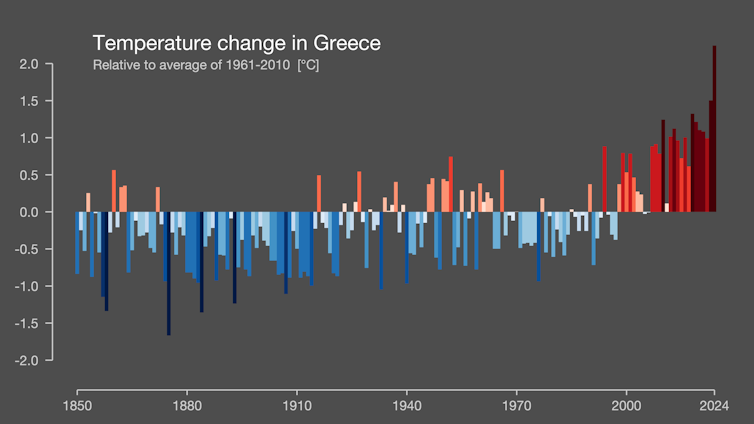Source: The Conversation – UK – By John Kenneth Paranada, Curator of Art and Climate Change, University of East Anglia
Water is at the heart of the disruption wrought by climate change. The seas, once seen as vast and stable, are now unpredictable and restless.
That tidy, looping diagram of the water cycle once pinned up in primary school classrooms – clouds, rivers, evaporation and rain – now reads more like a fragmented recollection than a dependable process. Human impact has cracked that once-stable loop wide open.
Sea levels inch upward year on year. Droughts grow more prolonged and severe. Rainfall becomes erratic and violent. What was once spoken of in future tense is now present and pressing.
In Norfolk, land and sea have long coexisted in an uneasy truce. Here, the threat of sea level rise is not a speculative concern, it is data-backed, visible and accelerating.
According to research from the Tyndall Centre for Climate Change Research, vast swathes of Norfolk risk being submerged by rising seas if global temperatures rise by even two degrees celsius. It is one of the most at-risk areas in the UK.
Against this backdrop comes the Sainsbury Centre’s exhibition, A World of Water (part of the Can the Seas Survive Us? season). In the show, water is explored as subject, medium and metaphor. It is both agent and witness, shaping civilisations, sustaining life, and now challenging our ability to coexist with it.
Curated through an interdisciplinary lens, the exhibition was shaped by deep collaboration with scientists, artists, ecologists, activists and coastal communities. Rooted in lived experience, from a two-day walk along the Wherry Man’s Way to a 36-hour sail aboard a 1921 fishing smack, the curatorial process traced fragile coastlines and the North Sea’s rapid transformation into an industrial nexus of energy infrastructures.
Looking for something good? Cut through the noise with a carefully curated selection of the latest releases, live events and exhibitions, straight to your inbox every fortnight, on Fridays. Sign up here.
The curatorial approach to the show embraces the multifaceted nature of water by weaving together maritime history, Indigenous knowledge and contemporary works rooted in the artists’ experiences.
Many of the participating artists hail from communities already wrestling with rising tides and the realities of climate disruption. Their contributions form three thematic currents: Mudplume, Water Water Everywhere and In a State of Flux.
These overlapping threads investigate how water connects, nourishes and imperils. Rather than positioning the sea as a line of division, the exhibition reframes it as a living, connective tissue linking culture, history and ecology.
A curatorial geomorphology of the sea
Guidance for the exhibition’s conceptual framework came, fittingly, from water itself. Its mutable nature – solid, liquid, vapour – shaped the rhythm of the curatorial process. Rather than impose a rigid thesis, the exhibition offers an ever-shifting constellation of perspectives.
The exhibition journey begins with sound. Visitors are welcomed by a low murmur, tides lapping, water dripping, echoing through the museum entrance. This leads to Spiral Fosset (2024), a sculptural work by the Dutch collective De Onkruidenier.
Mirroring the central staircase of the museum, the piece suggests the brackish confluence where fresh and saltwater mingle. From here, the viewer descends into the lower galleries, reimagined as an estuary.
Within the lower galleries, artworks unfold like coastal mudflats at low tide. Seventeenth-century Dutch seascapes hang alongside photographs, video works and sculptures made from plastic waste. Sands from the beaches of Cromer, Happisburgh and Cley are featured, anchoring the exhibition in local terrain.
East Anglia’s centuries-old ties with the Low Countries form a steady through line. Hendrick van Anthonissen’s View of Scheveningen Sands (1641) shares space with works by Norwich School masters such as John Sell Cotman, John Crome and Robert Ladbrooke.
This approach privileges resonance over chronology. The exhibition avoids a linear march through time in favour of prioritising association, connection and drift. For instance, Shore Compass by Olafur Eliasson (2019) sits in subtle dialogue with Jodocus Hondius’s 1589 Drake Map an early cartographic rendering of Sir Francis Drake’s circumnavigation of the world.
Created during the height of European maritime expansion and colonialism, the map illustrates the interplay between empire, navigation and power. Time, like tide, is allowed to meander.
The exhibition adopts what might be called a “curatorial geomorphology”: a way of curating that draws on the sculpting force of water. In the natural sciences, geomorphology examines how landscapes are formed and reshaped by flowing water, storms and tides, while hydrology traces water’s movement through the environment.
This curatorial approach translates those scientific ideas into a cultural and creative practice. Like a river, it flows through histories, stories and meanings. What unfolds is a tidal narrative, an estuary of thought where time loosens, the present deepens and new futures begin to surface.
Visitors to A World of Water can expect something different from a traditional gallery experience. It invites you to think with the seas, to tune into their rhythms, tensions and secret lives.
As you wander through the galleries, you enter a realm shaped by flux, expect to feel and reimagine a world where land, water and life move as one. And perhaps, by moving as water does, we may begin to sense an answer to the question: Can the Seas Survive Us? Not in certainty, but through our collective and individual actions toward a more regenerative and sustainable future.
A World of Water is at the Sainsbury Centre Norwich until August 3. It’s part of a six-month season of interlinked exhibitions and events that explore the question: “Can the seas survive us?”
Get your news from actual experts, straight to your inbox. Sign up to our daily newsletter to receive all The Conversation UK’s latest coverage of news and research, from politics and business to the arts and sciences.
![]()
John Kenneth Paranada received funding from the John Ellerman Foundation; the Art Fund’s Jonathan Ruffer Curatorial Grant; the Association of Art Museum Curators’ EPIC Curatorial Fellowship Award; the Mondriaan Fund’s International Art Presentation Grant; the Kingdom of the Netherlands’ Cultural Diplomacy Grant; and Arts Council England’s National Lottery Fund for the project A World of Water: Can the Seas Survive Us? at the Sainsbury Centre.
– ref. A World of Water exhibition asks: ‘Can the seas survive us?’ – https://theconversation.com/a-world-of-water-exhibition-asks-can-the-seas-survive-us-262057




